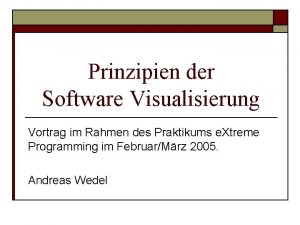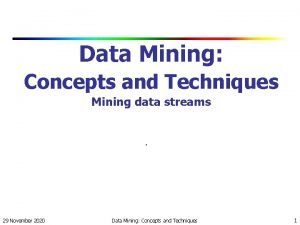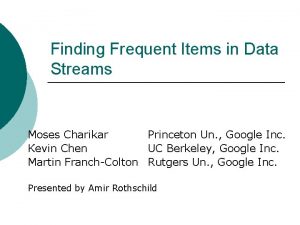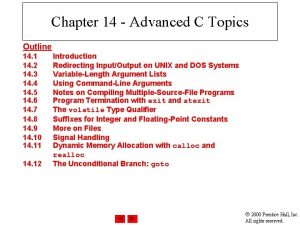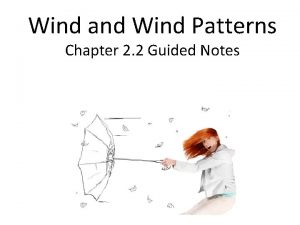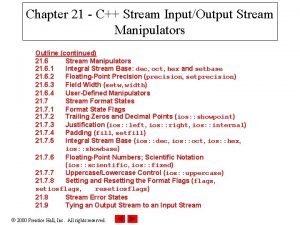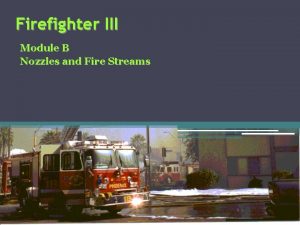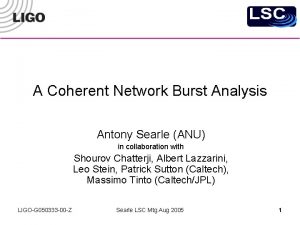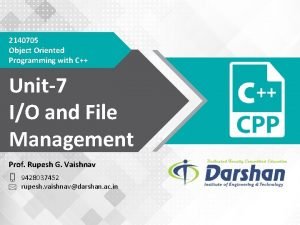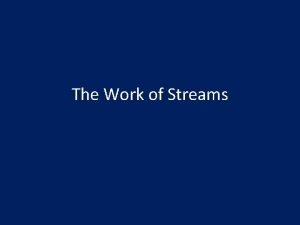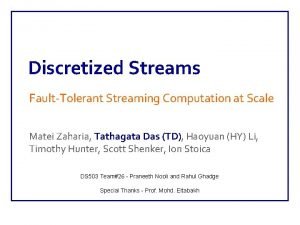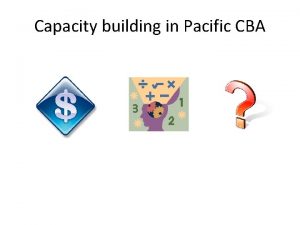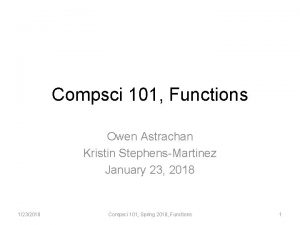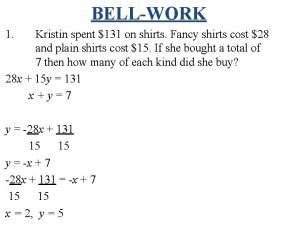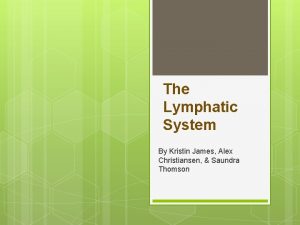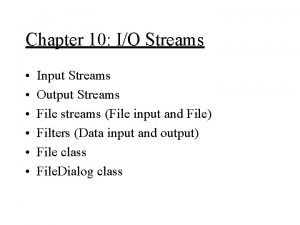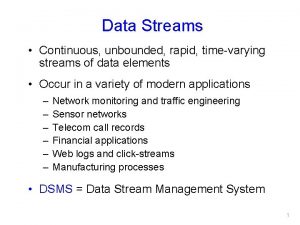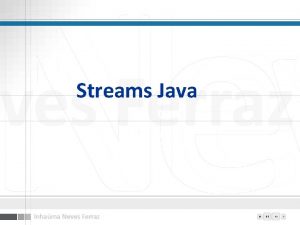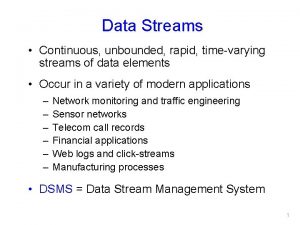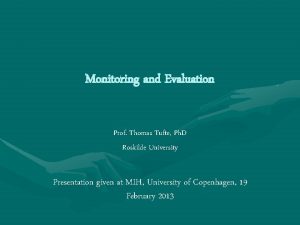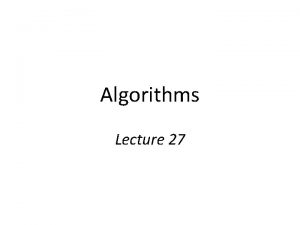CS 487587 Advanced Topics Data Streams Kristin Tufte











![WID Implementation SELECT auctionid, AVG(amt) FROM Bids [Range 5 Minutes Slide 1 Minute] GROUP WID Implementation SELECT auctionid, AVG(amt) FROM Bids [Range 5 Minutes Slide 1 Minute] GROUP](https://slidetodoc.com/presentation_image_h/2c09fc0e32ab07d048a2b84302f26c1e/image-12.jpg)


![WID Implementation SELECT auctionid, AVG(amt) FROM Bids [Range 5 Minutes Slide 1 Minute] GROUP WID Implementation SELECT auctionid, AVG(amt) FROM Bids [Range 5 Minutes Slide 1 Minute] GROUP](https://slidetodoc.com/presentation_image_h/2c09fc0e32ab07d048a2b84302f26c1e/image-15.jpg)




![SELECT aid, MAX(amt) FROM Bids [RANGE 3 Minutes SLIDE 1 Minute] GROUP BY aid SELECT aid, MAX(amt) FROM Bids [RANGE 3 Minutes SLIDE 1 Minute] GROUP BY aid](https://slidetodoc.com/presentation_image_h/2c09fc0e32ab07d048a2b84302f26c1e/image-20.jpg)




![WID Implementation SELECT auctionid, AVG(amt) FROM Bids [Range 5 Minutes Slide 1 Minute] GROUP WID Implementation SELECT auctionid, AVG(amt) FROM Bids [Range 5 Minutes Slide 1 Minute] GROUP](https://slidetodoc.com/presentation_image_h/2c09fc0e32ab07d048a2b84302f26c1e/image-25.jpg)




























- Slides: 53

CS 487/587 Advanced Topics: Data Streams Kristin Tufte Thanks to: David Maier, Jenny Li, Vassilis Papadimos 3/8/2021 1

History n n Joint project with University of Wisconsin – Madison and PSU (was OGI), funded by National Science Foundation (NSF) Niagara was originally for querying the Internet q n Retrieve, store, index XML files available on the Internet At PSU, we’ve studied stream processing q q 3/8/2021 Have modified Niagara v 1. 0 (developed at Wisconsin) to turn it into a data stream system Window aggregate processing in particular Data Streams: Lecture 4 2

Niagara. ST Architecture Niagara. STServer Niagara. ST Client connecti on request, queries 3/8/2021 Logical Physical operator DAG of Quer s s Query DAG of physica y Engine logical ops pars er parsed querie XML Optimizer s (ndom) Data Connecti Manag on er Manager Data Streams: Lecture 4 data strea m 3

Niagara v 1. 0 Queries n n n Pipelined system Each operator is a thread. Operators are connected by queues of tuples Operators wait on input queue, when tuple is ready, it is processed and result is inserted in output queue Simple scheduler q n n creates operators and connects them Control Messages upstream Not stream-specific! 3/8/2021 Data Streams: Lecture 4 sum select xmlscan 4

Why Isn’t This Good Enough? sum select xmlscan 3/8/2021 Data Streams: Lecture 4 5

Because… Problem is here! n n Stream may never end, must have a mechanism for producing results Select is not blocking (OK) Sum is blocking (problem) Use windows (and punctuation) to unblock sum select xmlscan 3/8/2021 Data Streams: Lecture 4 6

Niagara. ST Query Execution n Modified SQL operators q q n i. e. window. Sum Keep modifications minimal bucket i. e. bucket Isolate window semantics in these operators select Stream-specific operators q window. Sum Queues contain tuples and “punctuation” xmlscan 3/8/2021 Data Streams: Lecture 4 7

Running Example n n n On-line auction site – produces a stream of bids May receive bids from multiple sites For now assume: q q n Receive bids from one site Bids arrive in order of the time attribute Schema: 3/8/2021 Bids(auctionid, bidderid, amt, time) Data Streams: Lecture 4 8

Window Definition n n Time-based windows – specify Range and Slide Find the average bid on each auction in the past 5 minutes, update the result every minute SELECT auctionid, AVG(amt) FROM Bids [Range 5 Minutes Slide 1 Minute] GROUP BY auctionid Bids(auctionid, bidderid, amt, time) 3/8/2021 Data Streams: Lecture 4 9

Windows Example t 1 t 2 t 3 t 4 t 5 t 6 t 7 (auctionid, amt, time(hh: mm: ss)) ( 3, 37. 00, 12: 00: 30 ) ( 28, 54. 00, 12: 01: 45 ) ( 42, 31. 00, 12: 02: 55 ) ( 23, 25. 00, 12: 04: 20 ) ( 4, 103. 00, 12: 05: 15 ) ( 82, 92. 00, 12: 05: 55 ) ( 21, 87. 00, 12: 09: 15 ) windows: W 1: 12: 00 – 12: 05: 00 W 2: 12: 01: 00 – 12: 06: 00 W 3: 12: 00 – 12: 07: 00 3/8/2021 W 2 W 3 SELECT auctionid, AVG(amt) FROM Bids [Range 5 Minutes Slide 1 Minute] GROUP BY auctionid Data Streams: Lecture 4 10

Explicit Window Ids n n Idea: Identify windows with a window id Tag tuples with the ids of the windows they belong to (explicit WID attribute) New operator: Given Range and Slide Bucket tags tuples with WID Add WID to the list of grouping attributes for the aggregation operator 3/8/2021 Data Streams: Lecture 4 11
![WID Implementation SELECT auctionid AVGamt FROM Bids Range 5 Minutes Slide 1 Minute GROUP WID Implementation SELECT auctionid, AVG(amt) FROM Bids [Range 5 Minutes Slide 1 Minute] GROUP](https://slidetodoc.com/presentation_image_h/2c09fc0e32ab07d048a2b84302f26c1e/image-12.jpg)
WID Implementation SELECT auctionid, AVG(amt) FROM Bids [Range 5 Minutes Slide 1 Minute] GROUP BY auctionid (auctionid, window-id, average) ( 10, 3, $6. 50) window. Average (group on window-id, auctionid) Window operation converted to a group by (auctionid, amt, time, window-id) ( 10, $5. 00, 12: 04: 35 PM, 1 -5) t 1 ( 10, $8. 00, 12: 06: 40 PM, 3 -7) t 2 bucket RANGE 5 minutes SLIDE 1 minute WATTR time (auctionid, amt, time ) ( 10, $5. 00, 12: 04: 35 PM) t 1 ( 10, $8. 00, 12: 06: 40 PM) t 2 xmlscan 3/8/2021 Data Streams: Lecture 4 12

What’s Wrong? n n When do you output? When the window ends How do you know when window ends? One solution: Punctuation q q q 3/8/2021 Looks like a tuple Interspersed with tuples in the inter-operator queues Indicates a certain subset of data is complete Data Streams: Lecture 4 13

Idea: Punctuation n Bucket will generate a “punctuation” to notify window. Average that window 1 is complete Punctuations look like tuples and are intermixed with tuples in inter-operator queues This punctuation says: all data with wid=1 has been seen. (aid, amt, time, wid) ( *, *, *, 1 ) 3/8/2021 Data Streams: Lecture 5 punctuation 14
![WID Implementation SELECT auctionid AVGamt FROM Bids Range 5 Minutes Slide 1 Minute GROUP WID Implementation SELECT auctionid, AVG(amt) FROM Bids [Range 5 Minutes Slide 1 Minute] GROUP](https://slidetodoc.com/presentation_image_h/2c09fc0e32ab07d048a2b84302f26c1e/image-15.jpg)
WID Implementation SELECT auctionid, AVG(amt) FROM Bids [Range 5 Minutes Slide 1 Minute] GROUP BY auctionid (auctionid, window-id, average) ( 10, 3, $6. 50) window. Average (group on window-id, auctionid) (auctionid, amt, time, window-id) ( 10, $5. 00, 12: 04: 35 PM, 1 -5) t 1 ( 10, $8. 00, 12: 06: 40 PM, 3 -7) t 2 ( *, *, *, 3 ) p 1 bucket RANGE 5 minutes SLIDE 1 minute WATTR time (auctionid, amt, time ) ( 10, $5. 00, 12: 04: 35 PM) t 1 ( 10, $8. 00, 12: 06: 40 PM) t 2 xmlscan 3/8/2021 Note: bucket generates punctuation Data Streams: Lecture 4 15

Niagara. ST WID Detailed Example Schema: Bids(auctionid, bidderid, amt, time) Query: Find the maximum bid price for each auction over the past 3 minutes. Update the result each minute. (Simple window aggregate query. ) SELECT aid, MAX(amt) FROM Bids [Range 3 Minutes Slide 1 Minute] GROUP BY aid=auctionid 3/8/2021 Data Streams: Lecture 5 16

Niagara. ST Example – Data & Windows SELECT aid, MAX(amt) FROM Bids [RANGE 3 Minutes SLIDE 1 Minute] GROUP BY aid t 1 t 2 t 3 t 4 t 5 t 6 t 7 t 7 (aid, ( 8, ( 9, ( 8, ( 9, ( 8, 3/8/2021 amt, 37. 00, 54. 00, 61. 00, 35. 00, 42. 00, 45. 00, 67. 00, 57. 00, 65. 00, 72. 00, time) 12: 00: 03) 12: 00: 34) 12: 01: 10) 12: 02: 15) 12: 03: 51) 12: 04: 35) 12: 05: 15) 12: 05: 20) 12: 06: 30) 12: 07: 45) n 12: 00 -12: 03 12: 01 -12: 04 12: 02 -12: 05 12: 03 -12: 06 12: 04 -12: 07 12: 05 -12: 08 Data Streams: Lecture 5 Want output every minute, but don’t have 3 minutes of data at startup time 17

Niagara. ST Example – Data & Windows SELECT aid, MAX(amt) FROM Bids [RANGE 3 Minutes SLIDE 1 Minute] GROUP BY aid t 1 t 2 t 3 t 4 t 5 t 6 t 7 t 7 (aid, ( 8, ( 9, ( 8, ( 9, ( 8, 3/8/2021 amt, 37. 00, 54. 00, 61. 00, 35. 00, 42. 00, 45. 00, 67. 00, 57. 00, 65. 00, 72. 00, time) 12: 00: 03) 12: 00: 34) 12: 01: 10) 12: 02: 15) 12: 03: 51) 12: 04: 35) 12: 05: 15) 12: 05: 20) 12: 06: 30) 12: 07: 45) W 1 W 2 W 3 W 4 W 5 W 6 W 7 W 8 n Partial windows at start-up windows: W 1: 12: 00 W 2: 12: 00 W 3: 12: 00 W 4: 12: 01: 00 W 5: 12: 00 W 6: 12: 03: 00 W 7: 12: 04: 00 W 8: 12: 05: 00 Data Streams: Lecture 5 – – – – 12: 01: 00 12: 03: 00 12: 04: 00 12: 05: 00 12: 06: 00 12: 07: 00 12: 08: 00 18

Tuples Belong to Multiple Windows SELECT aid, MAX(amt) FROM Bids [RANGE 3 Minutes SLIDE 1 Minute] GROUP BY aid t 1 t 2 t 3 t 4 t 5 t 6 t 7 t 7 (aid, ( 8, ( 9, ( 8, ( 9, ( 8, 3/8/2021 amt, 37. 00, 54. 00, 61. 00, 35. 00, 42. 00, 45. 00, 67. 00, 57. 00, 65. 00, 72. 00, time) 12: 00: 03) 12: 00: 34) 12: 01: 10) 12: 02: 15) 12: 03: 51) 12: 04: 35) 12: 05: 15) 12: 05: 20) 12: 06: 30) 12: 07: 45) windows: W 1: 12: 00 W 2: 12: 00 W 3: 12: 00 W 4: 12: 01: 00 W 5: 12: 00 W 6: 12: 03: 00 W 7: 12: 04: 00 W 8: 12: 05: 00 Data Streams: Lecture 5 – – – – 12: 01: 00 12: 03: 00 12: 04: 00 12: 05: 00 12: 06: 00 12: 07: 00 12: 08: 00 19
![SELECT aid MAXamt FROM Bids RANGE 3 Minutes SLIDE 1 Minute GROUP BY aid SELECT aid, MAX(amt) FROM Bids [RANGE 3 Minutes SLIDE 1 Minute] GROUP BY aid](https://slidetodoc.com/presentation_image_h/2c09fc0e32ab07d048a2b84302f26c1e/image-20.jpg)
SELECT aid, MAX(amt) FROM Bids [RANGE 3 Minutes SLIDE 1 Minute] GROUP BY aid Window Ids n t 1 t 2 t 3 t 4 t 5 t 6 t 7 t 7 Assign explict window ids (WIDs) to tuples (aid, ( 8, ( 9, ( 8, ( 9, ( 8, 3/8/2021 amt, 37. 00, 54. 00, 61. 00, 35. 00, 42. 00, 45. 00, 67. 00, 57. 00, 65. 00, 72. 00, time) 12: 00: 03) 12: 00: 34) 12: 01: 10) 12: 02: 15) 12: 03: 51) 12: 04: 35) 12: 05: 15) 12: 05: 20) 12: 06: 30) 12: 07: 45) WIDS [1 -3] [2 -4] [3 -5] [4 -6] [5 -7] [6 -8] [7 -9] [8 -10] Data Streams: Lecture 5 windows: W 1: W 2: W 3: W 4: W 5: W 6: W 7: W 8: 12: 00: 00 12: 01: 00 12: 03: 00 12: 04: 00 12: 05: 00 – – – – 12: 01: 00 12: 03: 00 12: 04: 00 12: 05: 00 12: 06: 00 12: 07: 00 12: 08: 00 20

Example aid wid max 8 1 37. 00 54. 00 8 2 37. 00 54. 00 8 3 37. 00 54. 00 window. Max state (hash table) window. Max groups on: aid, wid (aid, amt, time, wid) ( 8, 54. 00, 37. 00, 12: 00: 34, 12: 00: 03, 1 -3) t 1 t 2 bucket (aid, amt, time) ( 8, 54. 00, 37. 00, 12: 00: 34) 61. 00, 12: 00: 03) t 2 12: 01: 10) t 1 t 3 xmlscan 3/8/2021 windows: W 1: 12: 00 – 12: 01: 00 W 2: 12: 00 – 12: 00 Data Streams: Lecture W 3: 12: 00 – 12: 03: 00 21 5

aid wid Example window. Max groups on: aid, wid max 8 1 2 54. 00 61. 00 8 2 3 54. 00 61. 00 8 3 4 54. 00 61. 00 8 9 4 2 61. 00 35. 00 9 3 35. 00 Output: (aid, wid, max) (8, 1, 54. 00) 9 4 35. 00 (aid, amt, time, wid) (( 9, 8, *, 35. 00, 61. 00, *, 12: 01: 45, 12: 01: 10, *, 2 -4) 12 -4) ) p 1 t 4 t 3 bucket (aid, amt, time) ( 9, 8, 35. 00, 61. 00, 12: 01: 45) 12: 01: 10) t 4 t 3 xmlscan 3/8/2021 windows: W 1: 12: 00 – 12: 01: 00 W 2: 12: 00 – 12: 00 Data Streams: Lecture W 3: 12: 00 – 12: 03: 00 22 5

Bucket - WIDS t 1 t 2 t 3 t 4 t 5 t 6 t 7 t 7 (aid, ( 8, ( 9, ( 8, ( 9, ( 8, amt, time) 37. 00, 3) 54. 00, 34) 61. 00, 70) 35. 00, 135) 42. 00, 231) 45. 00, 275) 67. 00, 315) 57. 00, 320) 65. 00, 390) 72. 00, 465) WIDS [1 -3] [2 -4] [3 -5] [4 -6] [5 -7] [6 -8] [7 -9] [8 -10] Time is in seconds from 12: 00 n n n Query: [Range 180 Seconds Slide 60 Seconds] wids(time) = [ (time/SLIDE)+1, (time+RANGE)/SLIDE ] wids(231) = [(231/60)+1, (231+180)/60 ] = [4, 6] windows: W 1: W 3: W 5: W 7: 0 -60 0 -180 120 -300 240 -420 3/8/2021 W 2: W 4: W 6: W 8: 0 -120 60 -240 180 -360 360 -480 Data Streams: Lecture 5 23

Window Query Execution in Niagara. ST n Ideas: Explicit Window Ids & Punctuation Append a range of window ids (WIDs) to each tuple New operator: Bucket assigns WIDs to tuples Group by WID n Punctuation indicates end of windows n n n 3/8/2021 Data Streams: Lecture 5 24
![WID Implementation SELECT auctionid AVGamt FROM Bids Range 5 Minutes Slide 1 Minute GROUP WID Implementation SELECT auctionid, AVG(amt) FROM Bids [Range 5 Minutes Slide 1 Minute] GROUP](https://slidetodoc.com/presentation_image_h/2c09fc0e32ab07d048a2b84302f26c1e/image-25.jpg)
WID Implementation SELECT auctionid, AVG(amt) FROM Bids [Range 5 Minutes Slide 1 Minute] GROUP BY auctionid (auctionid, window-id, average) ( 10, 3, $6. 50) window. Average Group by WID Punctuation indicates end of windows (group on window-id, auctionid) (auctionid, amt, time, window-id) ( 10, $5. 00, 12: 04: 35 PM, 1 -5) t 1 ( 10, $8. 00, 12: 06: 40 PM, 3 -7) t 2 ( *, *, *, 3 ) p 1 bucket New operator: Bucket assigns ranges of WIDs to tuplesalso generates Bucket punctuation (auctionid, amt, time ) RANGE 5 minutes SLIDE 1 minute WATTR time ( ( 10, $5. 00, 12: 04: 35 PM) t 1 $8. 00, 12: 06: 40 PM) t 2 xmlscan 3/8/2021 Data Streams: Lecture 4 25

Advantages n n Window are not buffered (less memory) Window specification is isolated in bucket operator q q n Flexible q q n Average doesn’t know about windows No need for specialized window operators – just use punctuation-aware operators Window on system time, external time or tuple-based Data can arrive and be processed out of order Punctuation can guarantee progress q 3/8/2021 Gaps in tuple arrival need not affect result production Data Streams: Lecture 5 26

Niagara. ST Window Join Semantics SELECT A. id, A. name, B. bidderid, B. amt FROM Auctions A [RANGE 10 MINUTES SLIDE 2 MINUTES], Bids B [RANGE 5 MINUTES SLIDE 2 MINUTES] WHERE A. id = B. auctionid AND A. sellerid = 0 n n Map tuples in A and B to window ids using method described in previous slides Add A. wid = B. wid to the join condition: q 3/8/2021 A. id = B. auctionid AND A. wid = B. wid Data Streams: Lecture 5 27

DSMS Challenges n Unbounded Memory Requirements q q q n Blocking Operators q n Techniques for limiting the amount of memory required Sliding Windows Approximation: sampling, synopsis How to unblock them…(windows, punctuation) Tuple Arrival Gaps 3/8/2021 Data Streams: Lecture 5 28

Evaluate with Finite (Bounded) Memory? Schema: S 1(A, B, C) S 2(D, E) SELECT S 1. A FROM S 1 WHERE S 1. A>10 3/8/2021 Data Streams: Lecture 5 29

Your turn… Schema: S 1(A, B, C) S 2(D, E) Query 1: SELECT S 1. A FROM S 1, S 2 WHERE S 1. A = S 2. D Query 2: SELECT S 1. A FROM S 1, S 2 WHERE S 1. A = S 2. D AND S 1. A > 10 AND S 2. D < 20 3/8/2021 Data Streams: Lecture 5 30

Blocking Operators n Intuitively: An Op is blocking if it waits until the end of the stream to output results q q n Informally: An Op is non-blocking if: q n sum, count, min, max, sort are blocking What about difference and outer join? an additional input tuple does not cause updates to results for previous tuples Blocking Operators vs. Blocking Implementations q q 3/8/2021 Join is a non-blocking operator, but many join implementations are blocking (hash, sort-merge) Symmetric hash join is not blocking Data Streams: Lecture 5 31

Operator Summary n Finite vs. Unbounded Memory q q q n Finite: select, project Unbounded: join, sort, dupelim Aggregate classification is more complex Blocking vs. Non-Blocking q q 3/8/2021 Blocking: aggregates (min, max, count), sort Non-blocking: join, select, project, dupelim Data Streams: Lecture 5 32

Tuple Arrival Gaps n What is the problem? q Tuple 12: 01 n n closes window – what if the tuple doesn’t arrive? (8, 61, 12: 01: 10) t 3 12: 00 - If we are using tuple timestamps to figure out when to close windows, we are in trouble Can’t tell the difference between no data and a delayed tuple 3/8/2021 Data Streams: Lecture 5 33

aid wid Example max 8 1 54. 00 8 2 54. 00 61. 00 8 3 54. 00 61. 00 8 4 61. 00 Output: (aid, wid, max) (8, 1, 54. 00) (8, 2, 61. 00) (8, 3, 61. 00) (8, 4, 61. 00) window. Average groups on: aid, wid (aid, amt, time, wid) ( *, 8, 61. 00, *, 12: 01: 10, *, 12 -4) 2 3 4 ) p 4 p 1 t 3 p 2 p 3 bucket (aid, amt, time) ( 8, 65. 00, (10, 61. 00, 12: 04: 15) 12: 01: 10) t 4 t 3 xmlscan 3/8/2021 windows: W 1: 12: 00 – 12: 01: 00 W 2: 12: 00 – 12: 00 Data Streams: Lecture W 3: 12: 00 – 12: 03: 00 34 5

Tuple Arrival Gaps n Timeouts (Aurora) q Each windowed op has a timeout saying how long to wait for next tuple: n n (size = 10 tuples, step 2 tuples, timeout 5 sec) Punctuation (GS, Niagara. ST) q Application generates timestamps & punctuation …… Site A 3/8/2021 …… Site B tuples Data Streams: Lecture 5 …… Site C punctuation 35

Summary n Unbounded memory q n Blocking/non-blocking operators and implementations q n Windows, approximation Windows, punctuation Timestamps and tuple arrival gaps q 3/8/2021 Punctuation, heartbeats, slack Data Streams: Lecture 5 36

XML n n n Tree of elements – only one root element Elements have attributes (name, value) pairs and sub-elements Only simple XML used in the exercises <? xml version=“ 1. 0”> <department name = “CS”> <course name=“Data. Streams”> <time> TTh 10 -11: 50 </time> <location> FAB 150 </location> </course> <course> … </course> </department> 3/8/2021 Data Streams: Lecture 4 37

Example Query Plan Schema: Bids(auctionid, bidderid, amt, time) <? xml version="1. 0"? > <!DOCTYPE plan SYSTEM "/stash/datalab/datastreamsstudent/bin/queryplan. dtd"> <!-- This query selects the bidderid and amt for all bids with amt > $100 --> <!-- Specify the top operator in the query plan (last operator to be executed) --> <plan top="cons"> <!-- Scan the input file, extracting the attributes bidder and price --> <xmlscan id="scan" attrs="bidderid, amt" filename = "/stash/datalab/datastreamsstudent/streamdata/bids_small. xml" /> 3/8/2021 Data Streams: Lecture 5 38

Example Query Plan II <!-- Perform the selection --> <select id="selectop" input="scan"> <pred op="ge"> <var value="$amt"/> <number value="100"/> </pred> </select> <!-- Construct the result --> <construct id="cons" input="selectop"> <![CDATA[ <output> $bidderid $amt </output> ]]> </construct> </plan> 3/8/2021 Data Streams: Lecture 5 39

Input Data Streams<niagara: stream xmlns: niagara n n Data streams are faked using files Scan below on this file would produce two tuples, each with two attributes: $auctionid, $bidderid T 1 T 2 <xmlscan id=“scan” attrs=“auctionid, bidderid” file = “…”> 3/8/2021 ="http: //www. cs. pdx. edu/dot/nia gara"> <bids> <bid> <auctionid>0</auctionid> <time>1</time> <bidderid>2</bidderid> <amt>57. 00</amt> </bid> <auctionid>1</auctionid> <time>2</time> <bidderid>1</bidderid> <amt>147. 00</amt> </bids> </niagara: stream> Data Streams: Lecture 4 40

Window Aggregates in Niagara. ST Kristin Tufte, Jin Li Thanks to the Niagara. ST Group @ PSU Data Streams: Lecture 10 41

Outline n n Review of Window Aggregate Evaluation WID Window Semantics Panes Disordered Data and Out-of-order Processing Data Streams: Lecture 10 42

Window Aggregate – Buffering ( aid, ( a 5, ( a 6, max) 47 ) 48 ) window. Max (aid, t 1 (a 5, t 2 (a 6, t 3 (a 5, t 4 (a 5, t 5 (a 6, amt ts (hh: mm: ss)) 40, 01: 06: 30) 42, 01: 07: 45) 45, 01: 08: 15) 47, 01: 10) 48, 01: 10: 40) t 6 (a 6, 46, ( aid, t 4 t 6 t 5 ( a 6, a 5, 01: 11: 02) amt, ts ) 47, 46, 48, 01: 11: 02) 01: 10) 01: 10: 30) Data Streams: Lecture 10 window SELECT aid, MAX(amt) FROM Bids [Range 5 minutes Slide 1 minute Wattr ts] GROUP BY aid windows: window: 01: 06: 00 – 01: 11: 00 01: 07: 00 – 01: 12: 00 01: 08: 00 – 01: 13: 00 43

Window Aggregate Evaluation in wid max aid Niagara. ST …… …… …… -WID 70 a 5 max: 45 47 40 (aid, window-id, max) ( a 6, 70, 48 ) Max groups on: aid, wid (aid, amt, ts, window-id) t 4 t 5 p 1 t 6 t 1 t 2(( a 6, t 3 a 5, a 6, 40, 47, 48, 42, 45, *, 01: 11: 02, 01: 06: 30, 01: 10, 01: 10: 30, 01: 07: 45, 01: 08: 15, *, 70 -74 70 71 -75 )) …… …… …… 74 a 5 max: 45 47 40 70 a 6 max: 48 71 42 …… …… …… a 6 74 a 6 max: 48 42 a 6 max: 46 75 Bucket Range 5 minutes Slide 1 minute Wattr ts (aid, amt, ts ) p 1 t 4 ( a 6, t 5 t 6 t 1 t 2 t 3 s 5, 47, a 5, 48, 46, 40, 42, 45, *, 01: 10) 01: 10: 30) 01: 11: 02) 01: 06: 30) 01: 07: 45) 01: 08: 15) 01: 11: 00) Data Streams: Lecture 10 windows: 01: 06: 00 – 01: 11: 00 01: 07: 00 – 01: 12: 00 01: 08: 00 – 01: 13: 00 44

What’s the Difference n Window Semantics q q n Assumptions of data arrival order vs. Window-id Data arrival (query answer and result production) vs. Punctuation Query evaluation performance q q q Space Time Latency Data Streams: Lecture 10 45

Bucket n Bucket maps each tuple to windows: A 01: 03: 00 – 01: 08: 00 B 01: 04: 00 – 01: 09: 00 C 01: 05: 00 – 01: 10: 00 D 01: 06: 00 – 01: 11: 00 E 01: 07: 00 – 01: 12: 00 F 01: 08: 00 – 01: 13: 00 ( aid, amt, t 3 ( a 5, 45, t 2 ( a 6, 42, t 6 ( a 6, 46, t 1 ( a 5, 40, t 5 ( a 6, 48, t 4 ( s 5, 47, ts ) 01: 08: 15) 01: 07: 45) 01: 11: 02) 01: 06: 30) 01: 10: 10) [Range 5 minutes Slide 1 minute Wattr ts] Data Streams: Lecture 10 46

Window Semantics Framework in Niagara. ST n T: the set of all tuples in the input stream S: a window specification W: a set of window-ids In this lecture, we assume time starts at 0 n windows: (T, S) W n n n q n extent: (T, S, w) U T, where w W q n Defines the set of window ids to be used, e. g. , 0, 1, 2, … Specifies which tuples belong to a given window wids: (T, S, t) V W, where t T q q Determines the set of window-ids to which a tuple belongs Is the dual of extent Data Streams: Lecture 10 47

Handling Disorder n Sort (In-order processing) q q n Slack – BSort in Aurora Heartbeat in STREAM Sort-based Merge in Gigascope Output buffering and sorting in a shared-window join Space and time cost Data Streams: Lecture 10 48

Out-of-Order Processing n Out-of-order processing in Join q n M. A. Hammad, W. G. Aref, and A. K. Elmagarmid Optimizing In-Order Execution of Continuous Queries over Streamed Sensor Data. SSDBM 2005 Niagara. ST: Punctuation + Window-Id q Analogue to CPU’s out-of-order processing of instructions Data Streams: Lecture 10 49

Disorder Handling - WID Q 1: SELECT aid, MAX(amt) FROM Bids [Range 5 minutes Slide 1 minute Wattr ts] GROUP-BY aid wid (aid, window-id, max) ( a 6, 70, 48 ) Max Group on: wid, aid (aid, amt, ts, window-id) p 1 t 7 t 6(( a 6, a 5, a 6, 52, 46, *, 01: 10: 15, 01: 11: 02, *, 70 -74) 71 -75) 70 ) aid max …… …… …… 70 s 5 max: 52 47 …… …… …… 47 74 s 5 max: 52 71 70 s 6 max: 48 …… …… …… s 6 max: 48 74 s 6 max: 46 75 bucket (aid, amt, ts ) p 1 t 7 ( a 6, t 6 a 5, 46, 52, *, 01: 11: 02) 01: 10: 15) 01: 11: 00) Data Streams: Lecture 10 50

Sources of Punctuation n External Punctuation q n Data sources, e. g. , Gigascope Internal Punctuation q Mechanisms that can be used to generate punctuations n n Slack Heartbeat Data Streams: Lecture 10 51

Latency vs. Accuracy Band Disorder n n n Compare external punctuation and two flavors of slack As slack increases, error decreases and latency increases External punctuation has better latency and accuracy than slack Data Streams: Lecture 10 52

Latency vs. Accuracy Block-Sorted Disorder Latency vs. Accuracy Block-Sorted. Disorder (percentage of incorrect answers) Data Streams: Lecture 10 SELECT count (*) From Bids [Range 10 minutes Slide 1 minute Wattr ts] 53
 Thomas tufte
Thomas tufte Graphical excellence tufte
Graphical excellence tufte Forandringsprocess
Forandringsprocess Tufte challenger
Tufte challenger Data nugget streams as sensors answers
Data nugget streams as sensors answers Basic concepts in mining data streams
Basic concepts in mining data streams A framework for clustering evolving data streams
A framework for clustering evolving data streams Finding frequent items in data streams
Finding frequent items in data streams Advanced topics in software analysis and testing
Advanced topics in software analysis and testing Angular guard naming convention
Angular guard naming convention Advanced topics in angular
Advanced topics in angular Advanced c topics
Advanced c topics Advanced topics in web development
Advanced topics in web development Android advanced topics
Android advanced topics Advanced topics in computer science
Advanced topics in computer science Gulf stream
Gulf stream Characteristics of wetlands
Characteristics of wetlands Cost streams
Cost streams Streams aq: waiting for messages in the queue
Streams aq: waiting for messages in the queue Poljes
Poljes Travelers among mountains and streams
Travelers among mountains and streams Sand dune migration
Sand dune migration Cout setf ios fixed
Cout setf ios fixed Fire streams
Fire streams 3 types of fire streams
3 types of fire streams Oracle streams
Oracle streams Antony searle
Antony searle Concept of streams
Concept of streams Types of bodys of water
Types of bodys of water Snull
Snull In chemical dehumidification process
In chemical dehumidification process Java programs perform i/o through ……….. *
Java programs perform i/o through ……….. * High gradient stream
High gradient stream Most streams carry the largest part of their load
Most streams carry the largest part of their load Once there were brook trout in the streams in the mountains
Once there were brook trout in the streams in the mountains Wild swans at coole date
Wild swans at coole date Disappearing streams karst topography
Disappearing streams karst topography Vvvnn reviews
Vvvnn reviews Ibm business model canvas
Ibm business model canvas Virginia save our streams
Virginia save our streams Key partners
Key partners Perforce introduction
Perforce introduction Perforce virtual streams
Perforce virtual streams Discretized stream
Discretized stream Cba streams
Cba streams There's a place where mercy reigns and never dies
There's a place where mercy reigns and never dies Kristin harad
Kristin harad Kristin kersten
Kristin kersten Kristin fiorino
Kristin fiorino Kristin stephens-martinez
Kristin stephens-martinez Python tutor ames
Python tutor ames Kristin spent $131 on shirts answers
Kristin spent $131 on shirts answers Kristin james
Kristin james Kristin hamann
Kristin hamann

